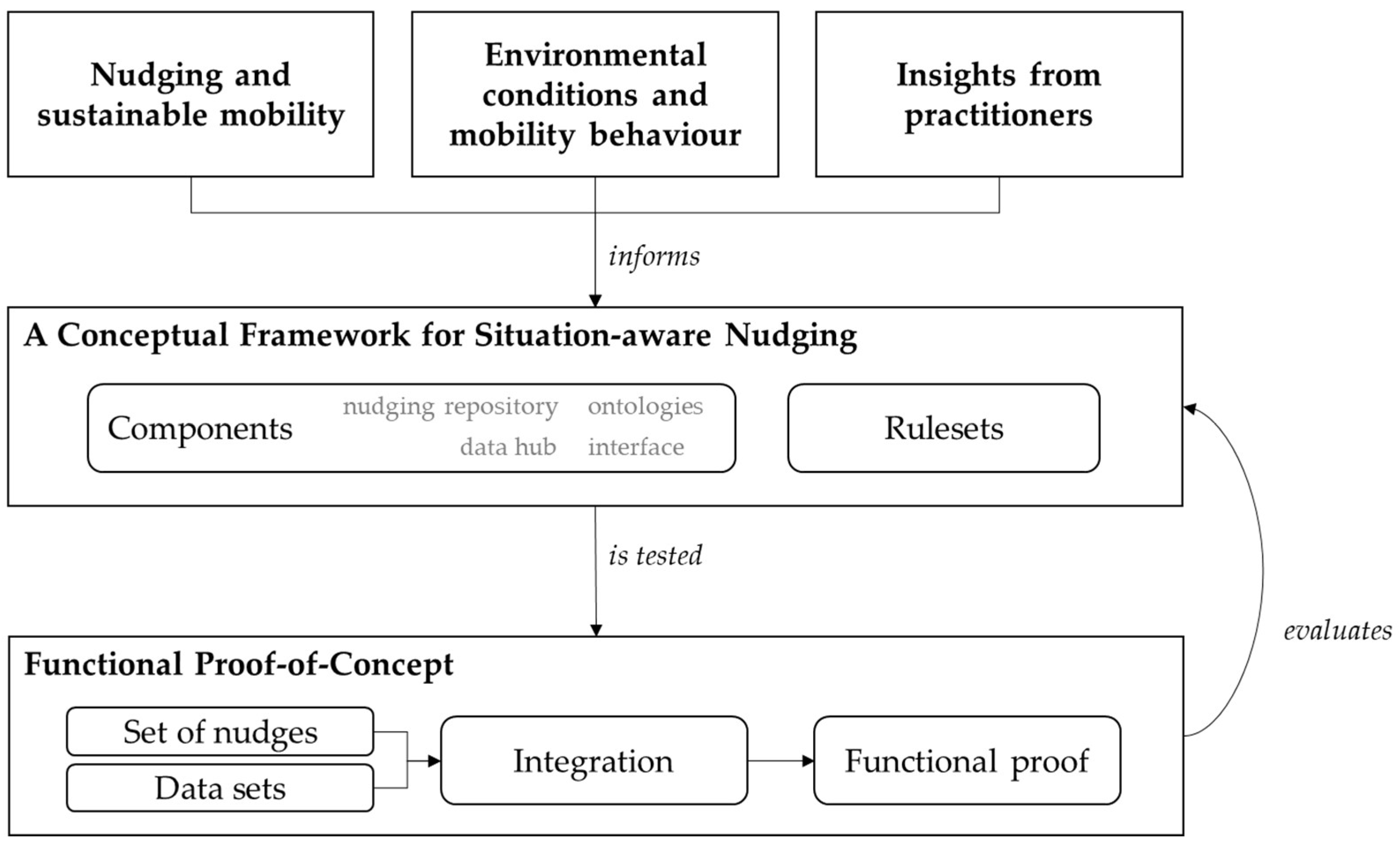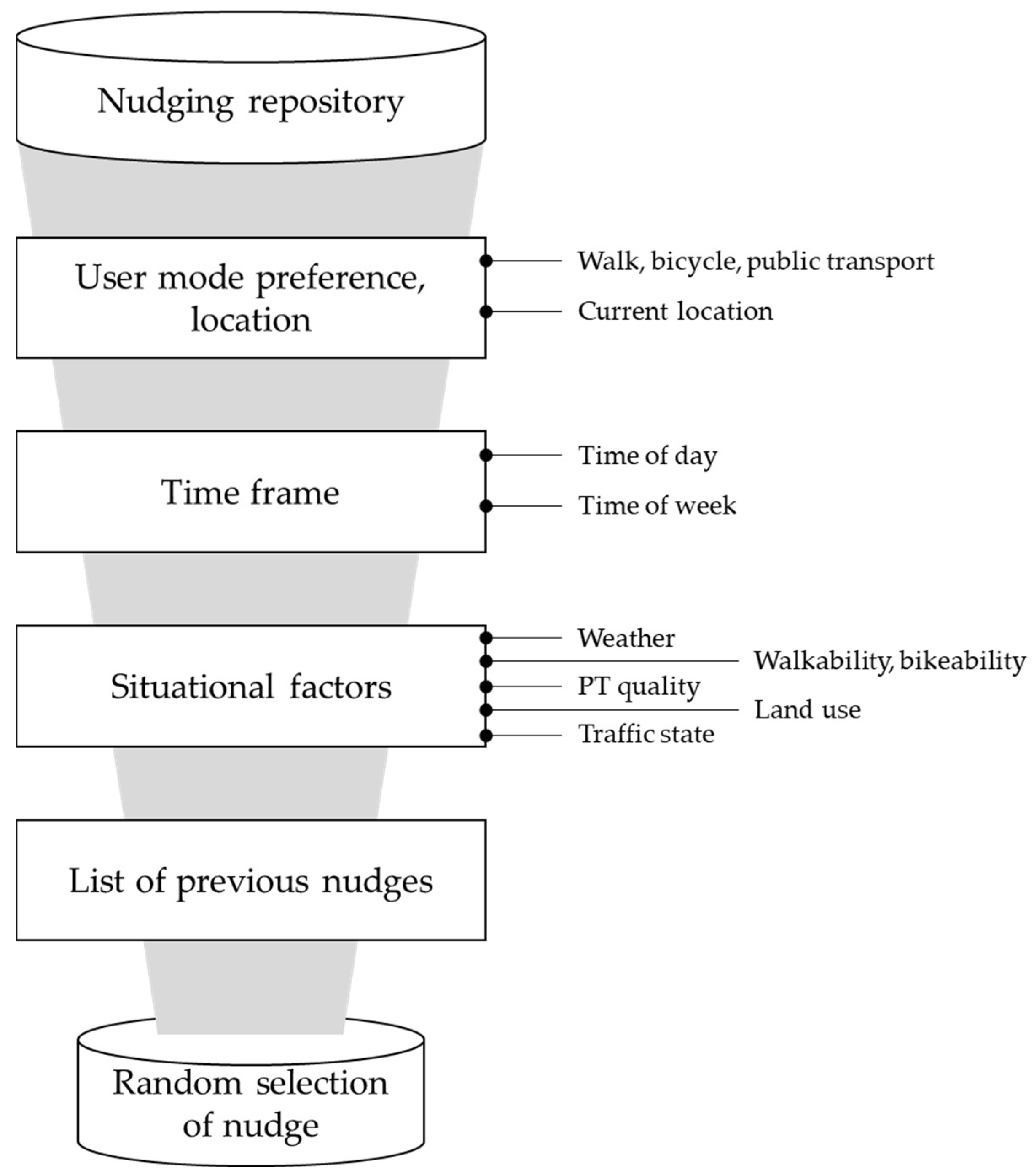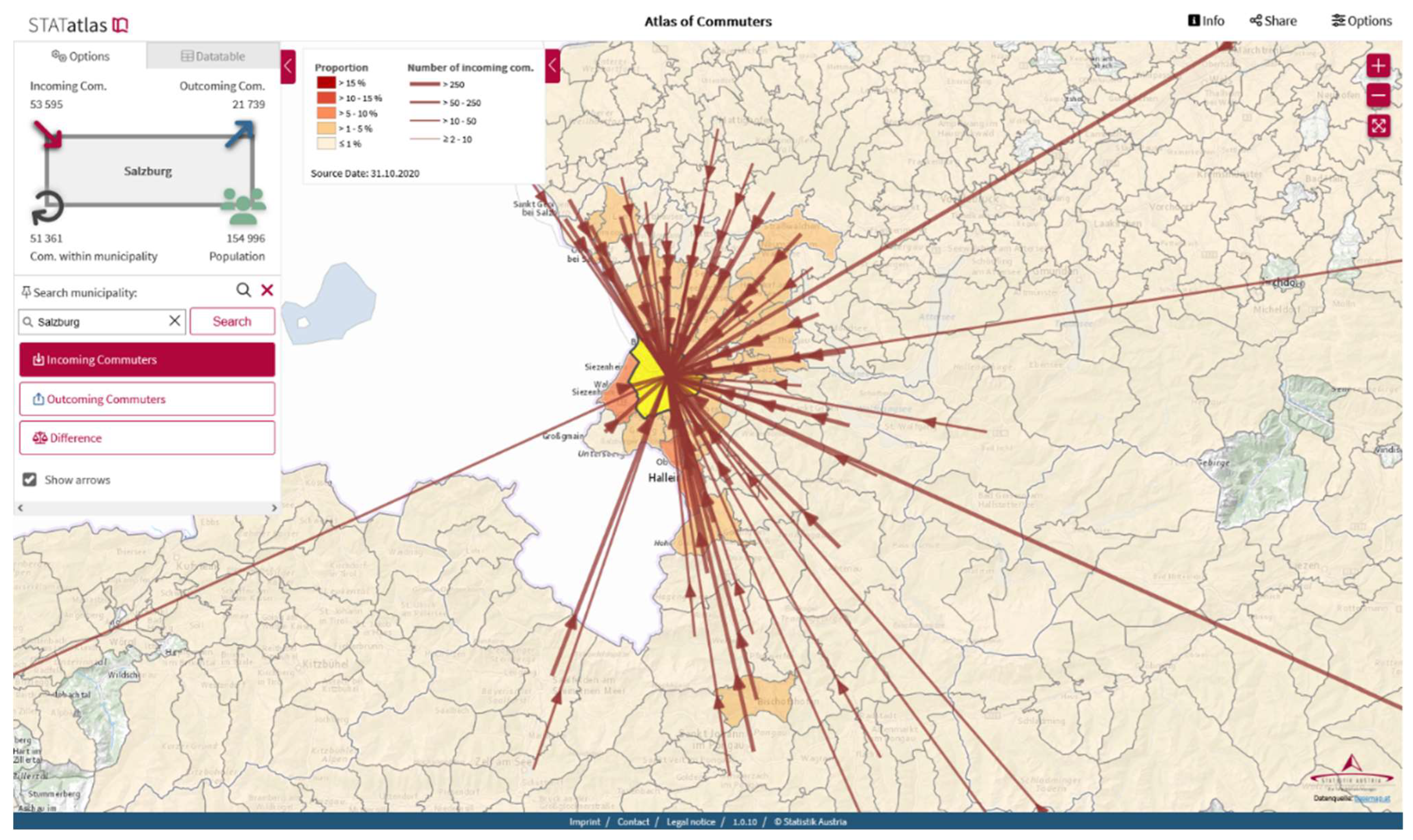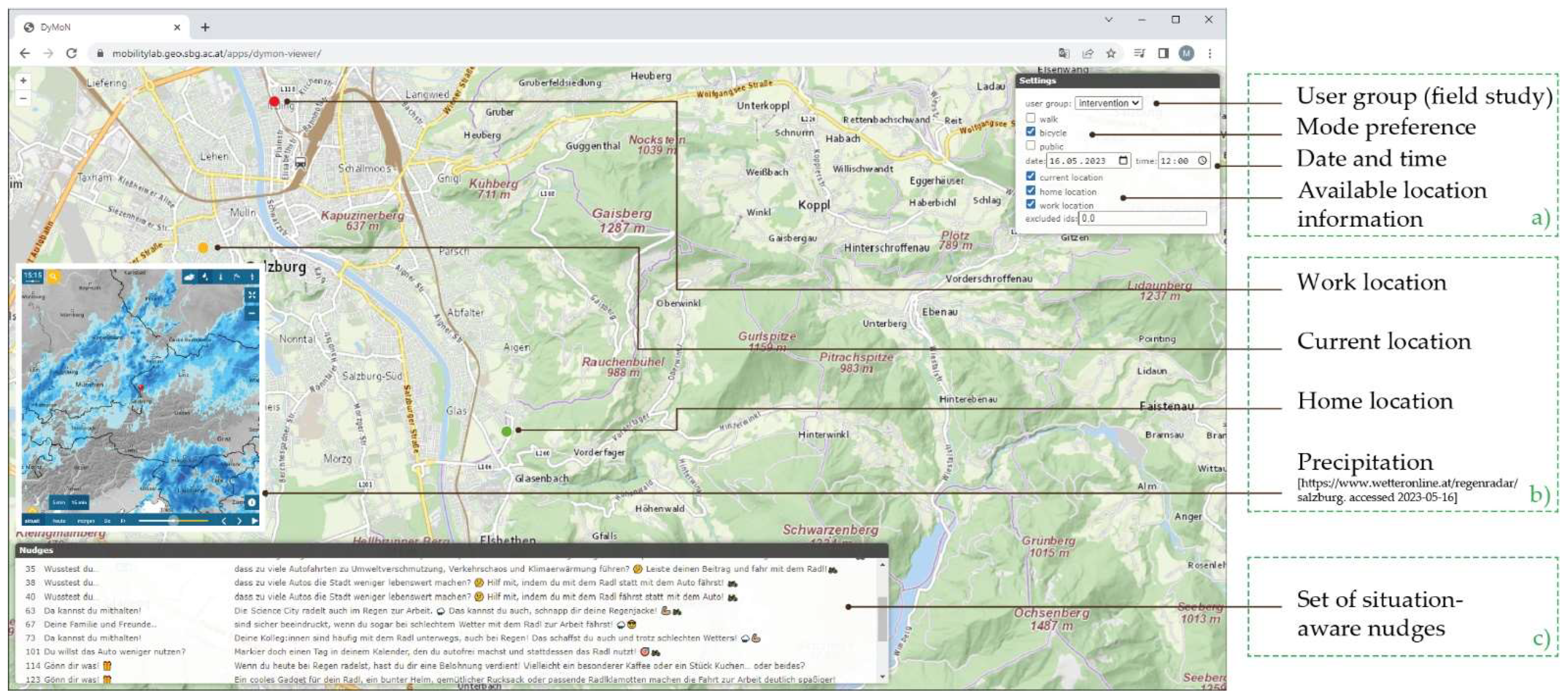Unlocking the Potential of Digital, Situation-Aware Nudging for Promoting Sustainable Mobility
Abstract
:1. Introduction
2. Background
2.1. Nudging and Sustainable Mobility
2.2. Environmental Conditions and Mobility Behavior
2.3. Insights from Practitioners
3. Method: A Conceptual Framework for Situation-Aware Nudging
- (a)
- Data: multiple real-time sensors and data sources are integrated;
- (b)
- Information: situations are described along external determinants for mobility choices;
- (c)
- Situation identification: an ontology translates definitions of situations into manageable framework conditions;
- (d)
- Trigger for nudges: situation-aware nudges are delivered to users following predefined rules.
3.1. Components
3.2. Rulesets
4. Results: Functional Proof-of-Concept
4.1. Set of Nudges
4.2. Data Sets
- Weather: data on an hourly forecast of air temperature, precipitation, wind speed, and sunshine duration are retrieved and either directly used or further processed; for instance, we calculated daily means from hourly values or estimated the probability of the presence of glaze from temperature and precipitation. All weather data are openly accessible;
- Public transport data: we use openly available national GTFS (General Transit Feed Specification) data for locations of public transport stops and timetables. From this data set, we calculate public transport accessibility and departure frequencies for each stop;
- Traffic situation: data on current and forecasted traffic state is used on the level of single road segments. Based on these data, we calculate a variable expressing the occurrence of congestion. For accessing the data, we use a nationally available proprietary service;
- Car parking: we use data on real-time occupation rates of car parking facilities for calculating the availability rate of car parking. For this, we use an openly accessible service for our study area. However, this data source is limited to managed parking facilities and does not consider on-street marking;
- Street network: we use an openly available, authoritative representation of the street network for deriving several quality indicators. The suitability and attractiveness of routes and surroundings of home/work/current location are assessed with the NetAScore tool [45];
- Mobility survey: for the definition of thresholds that describe reasonable situations (such as maximum walking distance to bus stops etc.), we use data from the last national, representative mobility survey. These data are freely available, but registration is required to access the full data set.
4.3. Integration
4.4. Functional Proof
5. Discussion
6. Conclusions
Author Contributions
Funding
Data Availability Statement
Acknowledgments
Conflicts of Interest
References
- Geels, F.W.; Sovacool, B.K.; Schwanen, T.; Sorrell, S. Sociotechnical transitions for deep decarbonization. Science 2017, 357, 1242–1244. [Google Scholar] [CrossRef] [PubMed]
- Gössling, S. Why cities need to take road space from cars—And how this could be done. J. Urban Des. 2020, 25, 443–448. [Google Scholar] [CrossRef]
- Banister, D. The sustainable mobility paradigm. Transp. Policy 2008, 15, 73–80. [Google Scholar] [CrossRef]
- Garcia-Sierra, M.; van den Bergh, J.C.J.M.; Miralles-Guasch, C. Behavioural economics, travel behaviour and environmental-transport policy. Transp. Res. Part D Transp. Environ. 2015, 41, 288–305. [Google Scholar] [CrossRef]
- Thaler, R.H.; Sunstein, C.R. Nudge: Improving Decisions about Health, Wealth and Happiness; Revised edition in Penguin Books; Penguin Books: London, UK, 2009. [Google Scholar]
- Beck, H. Was ist Behavioral Economics? In Behavioral Economics: Eine Einführung; Beck, H., Ed.; Springer Fachmedien Wiesbaden: Wiesbaden, Germany, 2014; pp. 1–24. [Google Scholar] [CrossRef]
- Tversky, A.; Kahneman, D. Judgment under Uncertainty: Heuristics and Biases. Science 1974, 185, 1124–1131. [Google Scholar] [CrossRef]
- Lehner, M.; Mont, O.; Heiskanen, E. Nudging—A promising tool for sustainable consumption behaviour? J. Clean. Prod. 2016, 134, 166–177. [Google Scholar] [CrossRef]
- Hummel, D.; Maedche, A. How effective is nudging? A quantitative review on the effect sizes and limits of empirical nudging studies. J. Behav. Exp. Econ. 2019, 80, 47–58. [Google Scholar] [CrossRef]
- Mertens, S.; Herberz, M.; Hahnel, U.J.J.; Brosch, T. The effectiveness of nudging: A meta-analysis of choice architecture interventions across behavioral domains. Proc. Natl. Acad. Sci. USA 2022, 119, e2107346118. [Google Scholar] [CrossRef]
- Schneider, C.; Weinmann, M.; vom Brocke, J. Digital nudging: Guiding online user choices through interface design. Commun. ACM 2018, 61, 67–73. [Google Scholar] [CrossRef]
- Klieber, K.; Luger-Bazinger, C.; Hornung-Prähauser, V.; Geser, G.; Wieden-Bischof, D.; Paraschivoiu, I.; Layer-Wagner, T.; Möstegl, N.; Huemer, F.; Rosan, J. Nudging sustainable behaviour: Data-based nudges for smart city innovations. In Proceedings of the ISPIM Innovation Conference, Virtual, 7–10 June 2020. [Google Scholar]
- Santos Silva, M. Nudging and Other Behaviourally Based Policies as Enablers for Environmental Sustainability. Laws 2022, 11, 9. [Google Scholar] [CrossRef]
- Lamb, W.F.; Grubb, M.; Diluiso, F.; Minx, J.C. Countries with sustained greenhouse gas emissions reductions: An analysis of trends and progress by sector. Clim. Policy 2022, 22, 1–17. [Google Scholar] [CrossRef]
- Schwanen, T.; Banister, D.; Anable, J. Rethinking habits and their role in behaviour change: The case of low-carbon mobility. J. Transp. Geogr. 2012, 24, 522–532. [Google Scholar] [CrossRef]
- Luger-Bazinger, C.; Hornung-Prähauser, V. Innovation for Sustainable Cities: The Effects of Nudging and Gamification Methods on Urban Mobility and Sustainability Behaviour. GI_Forum 2021, 9, 251–258. [Google Scholar] [CrossRef]
- Casquero, D.; Monzon, A.; García, M.; Martínez, O. Key Elements of Mobility Apps for Improving Urban Travel Patterns: A Literature Review. Future Transp. 2022, 2, 1–23. [Google Scholar] [CrossRef]
- Luger-Bazinger, C.; Geser, G.; Hornung-Prähauser, V. Digital behavioural interventions for sustainable mobility: A review of behaviour change techniques in mobile apps. In The Behavioral Economics Guide 2023; Samson, A., Ed.; Behavioral Science Solutions Ltd.: London, UK, 2023; pp. 68–75. [Google Scholar]
- Mont, O.; Lehner, M.; Heiskanen, E. Nudging—A Tool for Sustainable Behaviour? Swedish Environmental Protection Agency: Stockholm, Sweden, 2014.
- Anagnostopoulou, E.; Bothos, E.; Magoutas, B.; Schrammel, J.; Mentzas, G. Persuasive Technologies for Sustainable Mobility: State of the Art and Emerging Trends. Sustainability 2018, 10, 2128. [Google Scholar] [CrossRef] [Green Version]
- Sallis, J.F.; Cerin, E.; Conway, T.L.; Adams, M.A.; Frank, L.D.; Pratt, M.; Salvo, D.; Schipperijn, J.; Smith, G.; Cain, K.L.; et al. Physical activity in relation to urban environments in 14 cities worldwide: A cross-sectional study. Lancet 2016, 387, 2207–2217. [Google Scholar] [CrossRef] [Green Version]
- Eldeeb, G.; Mohamed, M.; Páez, A. Built for active travel? Investigating the contextual effects of the built environment on transportation mode choice. J. Transp. Geogr. 2021, 96, 103158. [Google Scholar] [CrossRef]
- Næss, P.; Peters, S.; Stefansdottir, H.; Strand, A. Causality, not just correlation: Residential location, transport rationales and travel behavior across metropolitan contexts. J. Transp. Geogr. 2018, 69, 181–195. [Google Scholar] [CrossRef]
- Gerike, R.; Koszowski, C.; Schröter, B.; Buehler, R.; Schepers, P.; Weber, J.; Wittwer, R.; Jones, P. Built Environment Determinants of Pedestrian Activities and Their Consideration in Urban Street Design. Sustainability 2021, 13, 9362. [Google Scholar] [CrossRef]
- Dalton, A.M.; Jones, A.P.; Panter, J.R.; Ogilvie, D. Neighbourhood, Route and Workplace-Related Environmental Characteristics Predict Adults’ Mode of Travel to Work. PLoS ONE 2013, 8, e67575. [Google Scholar] [CrossRef] [Green Version]
- Hamre, A.; Buehler, R. Commuter Mode Choice and Free Car Parking, Public Transportation Benefits, Showers/Lockers, and Bike Parking at Work: Evidence from the Washington, DC Region. J. Public Transp. 2014, 17, 67–91. [Google Scholar] [CrossRef] [Green Version]
- De Vos, J.; Cheng, L.; Kamruzzaman, M.; Witlox, F. The indirect effect of the built environment on travel mode choice: A focus on recent movers. J. Transp. Geogr. 2021, 91, 102983. [Google Scholar] [CrossRef]
- Ton, D.; Duives, D.C.; Cats, O.; Hoogendoorn-Lanser, S.; Hoogendoorn, S.P. Cycling or walking? Determinants of mode choice in the Netherlands. Transp. Res. Part A Policy Pract. 2019, 123, 7–23. [Google Scholar] [CrossRef]
- Bartoletti, S.; Chiaraviglio, L.; Fortes, S.; Kennouche, T.E.; Solmaz, G.; Bernini, G.; Giustiniano, D.; Widmer, J.; Barco, R.; Siracusano, G.; et al. Location-Based Analytics in 5G and Beyond. IEEE Commun. Mag. 2021, 59, 38–43. [Google Scholar] [CrossRef]
- Dix, A.; Finlay, J.; Abowd, G.D.; Beale, R. Human-Computer Interaction, 3rd ed.; Pearson Education Limited: Harlow, UK, 2004. [Google Scholar]
- Coutaz, J.; Crowley, J.L.; Dobson, S.; Garlan, D. Context is key. Commun. ACM 2005, 48, 49–53. [Google Scholar] [CrossRef]
- Potchter, O.; Cohen, P.; Lin, T.-P.; Matzarakis, A. Outdoor human thermal perception in various climates: A comprehensive review of approaches, methods and quantification. Sci. Total Environ. 2018, 631, 390–406. [Google Scholar] [CrossRef]
- Higgins, C.D.; Sweet, M.N.; Kanaroglou, P.S. All minutes are not equal: Travel time and the effects of congestion on commute satisfaction in Canadian cities. Transportation 2018, 45, 1249–1268. [Google Scholar] [CrossRef]
- Lättman, K.; Olsson, L.E.; Friman, M. A new approach to accessibility—Examining perceived accessibility in contrast to objectively measured accessibility in daily travel. Res. Transp. Econ. 2018, 69, 501–511. [Google Scholar] [CrossRef]
- Statistik Austria. Atlas der Erwerbspendler:Innen. Available online: https://www.statistik.at/atlas/pendler/ (accessed on 24 March 2023).
- Stadt Salzburg. Räumliches Entwicklungskonzept—Grundlagenbericht 2021. Available online: https://www.stadt-salzburg.at/rek-grundlagenbericht/ (accessed on 24 March 2023).
- Miltgen, C.L.; Peyrat-Guillard, D. Cultural and generational influences on privacy concerns: A qualitative study in seven European countries. Eur. J. Inf. Syst. 2014, 23, 103–125. [Google Scholar] [CrossRef]
- Hochwarter, C.; Jahnel, D.; Uhl, A. Public Perceptions, Preferences and Legal Aspects towards ATMs with Biometric Authentication in Austria. In Proceedings of the 2019 International Conference of the Biometrics Special Interest Group (BIOSIG), Darmstadt, Germany, 18–20 September 2019; pp. 1–6. [Google Scholar]
- Miller, H.J.; Shaw, S.-L. Geographic Information Systems for Transportation in the 21st Century. Geogr. Compass 2015, 9, 180–189. [Google Scholar] [CrossRef]
- Loidl, M. Datenverfügbarkeit für die räumliche Modellierung von Gefahrenbereichen im Straßenverkehr—Eine Untersuchung mittelgroßer Smart Cities in Europa. AGIT J. Angew. Geoinformatik 2021, 7, 117–123. [Google Scholar] [CrossRef]
- Luger-Bazinger, C.; Marquez, R.M.; Harms, C.; Loidl, M.; Kaziyeva, D.; Hornung-Prähauser, V. Ethics of digital, data-based nudges: The need for responsible innovation. In Proceedings of the XXXIII ISPIM Innovation Conference “Innovating in a Digital World”, Copenhagen, Denmark, 5–8 June 2022. [Google Scholar]
- Michie, S.; van Stralen, M.M.; West, R. The behaviour change wheel: A new method for characterising and designing behaviour change interventions. Implement. Sci. 2011, 6, 42. [Google Scholar] [CrossRef] [PubMed] [Green Version]
- Luger-Bazinger, C.; Leistner, D.; Geser, G.; Hornung-Prähauser, V.; Loidl, M.; Kaziyeva, D. Nudging Repository—Set of Nudges (DyMoN Project). Zenodo 2023. [Google Scholar] [CrossRef]
- Michie, S.; Richardson, M.; Johnston, M.; Abraham, C.; Francis, J.; Hardeman, W.; Eccles, M.P.; Cane, J.; Wood, C.E. The Behavior Change Technique Taxonomy (v1) of 93 Hierarchically Clustered Techniques: Building an International Consensus for the Reporting of Behavior Change Interventions. Ann. Behav. Med. 2013, 46, 81–95. [Google Scholar] [CrossRef] [PubMed]
- Werner, C.; Wendel, R.; Kaziyeva, D.; Stutz, P.; van der Meer, L.; Zagel, B.; Loidl, M. NetAScore—Network Assessment Score Toolbox for Sustainable Mobility. Available online: https://github.com/plus-mobilitylab/netascore (accessed on 12 May 2023).





| Examples | |
|---|---|
| Nudge text: informative | “Do you know that you can substantially reduce your risk for cardiovascular diseases by cycling to work at least three times a week?” “Healthy diet and regular physical activity lead to higher levels of well-being. Your daily commute is a perfect opportunity for walking or cycling.” “More than 50% of all trips are shorter than 7 km. This is the perfect distance for cycling and gaining health benefits while protecting the environment.” |
| Nudge text: call for action | “The sun is shining, and it will stay dry today. Get on your bike and collect extra points for our incentives store.” “Three of your colleagues are already on the train. Pick up your free ticket in the HR office and join them tomorrow.” |
| Nudge text: fixed vs. flexible elements | “Be on the safe side, stay dry, and take the bus to work.” vs. “It is going to rain for {x} hours today. The bus stop is only {m} meters from your home.” “Cycling is a rewarding experience for all age groups.” vs. “{age} years is the perfect age for {cycling not as preferred mode} rediscovering the joy of cycling.” |
| Nudge condition: situation | “Today is the perfect day for getting active. Let’s go to work by bike.” → {sunshine hours > 6 AND precipitation prognosis = 0 AND bikeability = high} “It is not far to work. Why not take a walk instead of using the car?” → {distance to work < 3 km AND walkability = high} |
| Nudge condition: user-specific characteristics and preferences | “Ladies are free on the bus today.” → {gender = female} “Do you know that the transport sector accounts for 30% of all GHG emissions? Better take the train.” → {car = preferred, public transport = optional, bicycle = no, walking = no} |
| Situational Factor | Quality | Value | Attribute 1 | Range 1 | Operator | Attribute 2 | Range 2 |
|---|---|---|---|---|---|---|---|
| Walkability | route | high | mean index_walk | [0, 0.5] | and | length m | [0, 4000] |
| proximity | high | mean index_walk | [0, 0.5] | and | distance m | [0, 400] | |
| Temperature | positive | daily mean temp °C | [0,) | ||||
| Glaze | no glaze | daily mean temp °C | (0,) | or | daily mean prec. mm | [0, 0] | |
| Green walk | proximity | present | mean index green | [0, 0.5] | and | distance m | [0, 400] |
| PT frequency | departures | high | dep. per hour | [6,) |
| Mode | Trip Purpose | Behavior Change Group | Behavior Change Technique |
|---|---|---|---|
| Bicycling 73 Public transport 31 Walking 61 | Commuting 62 Leisure 7 Commuting and Leisure 96 | Antecedents 5 Associations 20 Comparison of behavior 24 Comparison of outcomes 5 Covert learning 5 Goals and planning 16 Identity 9 Natural consequences 20 Regulation 4 Repetition and substitution 5 Reward and threat 6 Self-belief 15 Shaping knowledge 28 Social support 4 | Action planning 8 Adding objects to the environment 5 Anticipated regret 3 Behavior substitution 2 Comparative imagining of future outcomes 2 Focus on past success 3 Framing/reframing 3 Future punishment 4 Goal setting (behavior) 3 Habit formation 3 Imaginary punishment 3 Imaginary reward 2 Incompatible beliefs 3 Information about antecedents 7 Information about emotional consequences 15 Information about environmental consequences 6 Information about health consequences 6 Information about others’ approval 7 Information about social consequences 4 Instruction on how to perform a behavior 5 Mental rehearsal of successful performance 5 Monitoring of emotional consequences 2 Problem-solving 5 Prompts/cues 20 Pros and cons 3 Reduce negative emotions 4 Self-reward 2 Social comparison 17 Social support (unspecified and practical) 4 Valued self-identity 3 Verbal persuasion about capability 7 |
| Scenario 1a (Sunday, 8 p.m.) | Scenario 1b (Wednesday, 8 p.m.) |
|---|---|
| get_nudge(‘bicycle’, ‘20230507T200000’, None, ‘POINT(13.061541 47.788699)’, ‘POINT(13.0394319 47.8219307)’) get_nudges(‘bicycle’, ‘20230507T200000’, None, ‘POINT(13.061541 47.788699)’, ‘POINT(13.0394319 47.8219307)’) get_weather(‘20230507T200000’, ‘POINT(13.0394319 47.8219307)’) -> temperature(21 °C) = ‘moderate bicycle (work) (d1)’ -> precipitation(0 mm) = ‘no rainfall (work) (d1)’ -> glaze(21 °C, 0 mm) = ‘no glaze (work) (d1)’ -> wind(4 m/s) = ‘no strong winds (work) (d1)’ -> sunshine(482 min) = ‘sunshine (work) (d1)’ get_bikeability(None, ‘POINT(13.061541 47.788699)’, ‘POINT(13.0394319 47.8219307)’) -> bikeability(0.1476, 5852.88 m) = ‘high (home-work)’ -> nudges[] -> nudge.id = 2 -> nudge.title = ‘Tomorrow is a great day…’ -> nudge.text = ‘for taking the bike! Prepare for your trip to be on time and don’t forget anything.’ | get_nudge(‘bicycle’, ‘20230510T200000’, None, ‘POINT(13.061541 47.788699)’, ‘POINT(13.0394319 47.8219307)’) get_nudges(‘bicycle’, ‘20230510T200000’, None, ‘POINT(13.061541 47.788699)’, ‘POINT(13.0394319 47.8219307)’) get_weather(‘20230510T200000’, ‘POINT(13.0394319 47.8219307)’) -> temperature(26 °C) = ‘positive (work) (d1)’ -> precipitation(5 mm) = ‘rainfall (work) (d1)’ -> glaze(26 °C, 5 mm) = ‘no glaze (work) (d1)’ get_bikeability(None, ‘POINT(13.061541 47.788699)’, ‘POINT(13.0394319 47.8219307)’) -> bikeability(0.1476, 5852.88 m) = ‘high (home-work)’ -> nudges[] -> nudge.id = 4 -> nudge.title = ‘With your rain jacket …’ -> nudge.text = ‘you can cycle to work tomorrow despite the rain. You can do it!’ |
| Scenario 2a (Tuesday, 6 a.m.) | Scenario 2b (Thursday, 6 a.m.) |
|---|---|
| get_nudge(‘walk’, ‘20230509T060000’, None, ‘POINT(13.04482 47.801421)’, ‘POINT(13.0394319 47.8219307)’) get_nudges(‘walk’, ‘20230509T060000’, None, ‘POINT(13.04482 47.801421)’, ‘POINT(13.0394319 47.8219307)’) get_weather(‘20230509T060000’, ‘POINT(13.0394319 47.8219307)’) -> temperature(18 °C) = ‘moderate walk (work) (d0)’ -> precipitation(0 mm) = ‘no rainfall (work) (d0)’ -> wind(3 m/s) = ‘no strong winds (work) (d0)’ -> sunshine(345 min) = ‘sunshine (work) (d0)’ get_walkability(None, ‘POINT(13.04482 47.801421)’, ‘POINT(13.0394319 47.8219307)’) -> walkability(0.2771, 2879.95 m) = ‘high (home-work)’ -> nudges[] -> nudge.id = 90 -> nudge.title = ‘How about…’ -> nudge.text = ‘incorporating a little walk into your commute today? The weather is wonderful!’ | get_nudge(‘walk’, ‘20230511T060000’, None, ‘POINT(13.04482 47.801421)’, ‘POINT(13.0394319 47.8219307)’) get_nudges(‘walk’, ‘20230511T060000’, None, ‘POINT(13.04482 47.801421)’, ‘POINT(13.0394319 47.8219307)’) get_weather(‘20230511T060000’, ‘POINT(13.0394319 47.8219307)’) -> temperature(17 °C) = ‘moderate walk (work) (d0)’ -> precipitation(0 mm) = ‘no rainfall (work) (d0)’ -> wind(4 m/s) = ‘no strong winds (work) (d0)’ get_walkability(None, ‘POINT(13.04482 47.801421)’, ‘POINT(13.0394319 47.8219307)’) -> walkability(0.2771, 2879.95 m) = ‘high (home-work)’ get_traffic_state(‘POINT(13.04482 47.801421)’, ‘POINT(13.0394319 47.8219307)’) -> traffic_state(5) = ‘congested (home-work) (d0)’ -> nudges[] -> nudge.id = 93 -> nudge.title = ‘Congestion ahead’ -> nudge.text = ‘The streets are pretty crowded today... how about a walk to work?’ |
| Scenario 3a (Tuesday, 6 a.m.) | Scenario 3b (Friday, 6 a.m.) |
|---|---|
| get_nudge(‘public’, ‘20230509T060000’, None, ‘POINT(13.061541 47.788699)’, ‘POINT(13.0394319 47.8219307)’) get_nudges(‘public’, ‘20230509T060000’, None, ‘POINT(13.061541 47.788699)’, ‘POINT(13.0394319 47.8219307)’) get_pt_proximity(‘POINT(13.061541 47.788699)’) -> pt_proximity(6) = ‘present (home)’ get_pt_departure_frequency(‘20230509T060000’, ‘POINT(13.061541 47.788699)’) -> pt_departure_frequency(26.87) = ‘high (home) (d0)’ -> nudges[] -> nudge.id = 32 -> nudge.title = ‘You can save a lot of CO2 on a daily basis …’ -> nudge.text = ‘if you chose to take public transport instead of your car!’ | get_nudge(‘public’, ‘20230512T060000’, None, ‘POINT(13.061541 47.788699)’, ‘POINT(13.0394319 47.8219307)’) get_nudges(‘public’, ‘20230512T060000’, None, ‘POINT(13.061541 47.788699)’, ‘POINT(13.0394319 47.8219307)’) get_pt_proximity(‘POINT(13.061541 47.788699)’) -> pt_proximity(6) = ‘present (home)’ get_pt_departure_frequency(‘20230512T060000’, ‘POINT(13.061541 47.788699)’) -> pt_departure_frequency(26.87) = ‘high (home) (d0)’ get_pt_occupancy(‘POINT(13.061541 47.788699)’) -> pt_occupancy(50%) = ‘low (home) (d0)’ -> nudges[] -> nudge.id = 99 -> nudge.title = ‘A free seat is waiting for you!’ -> nudge.text = ‘How about taking public transport today?’ |
Disclaimer/Publisher’s Note: The statements, opinions and data contained in all publications are solely those of the individual author(s) and contributor(s) and not of MDPI and/or the editor(s). MDPI and/or the editor(s) disclaim responsibility for any injury to people or property resulting from any ideas, methods, instructions or products referred to in the content. |
© 2023 by the authors. Licensee MDPI, Basel, Switzerland. This article is an open access article distributed under the terms and conditions of the Creative Commons Attribution (CC BY) license (https://creativecommons.org/licenses/by/4.0/).
Share and Cite
Loidl, M.; Kaziyeva, D.; Wendel, R.; Luger-Bazinger, C.; Seeber, M.; Stamatopoulos, C. Unlocking the Potential of Digital, Situation-Aware Nudging for Promoting Sustainable Mobility. Sustainability 2023, 15, 11149. https://doi.org/10.3390/su151411149
Loidl M, Kaziyeva D, Wendel R, Luger-Bazinger C, Seeber M, Stamatopoulos C. Unlocking the Potential of Digital, Situation-Aware Nudging for Promoting Sustainable Mobility. Sustainability. 2023; 15(14):11149. https://doi.org/10.3390/su151411149
Chicago/Turabian StyleLoidl, Martin, Dana Kaziyeva, Robin Wendel, Claudia Luger-Bazinger, Matthias Seeber, and Charalampos Stamatopoulos. 2023. "Unlocking the Potential of Digital, Situation-Aware Nudging for Promoting Sustainable Mobility" Sustainability 15, no. 14: 11149. https://doi.org/10.3390/su151411149
APA StyleLoidl, M., Kaziyeva, D., Wendel, R., Luger-Bazinger, C., Seeber, M., & Stamatopoulos, C. (2023). Unlocking the Potential of Digital, Situation-Aware Nudging for Promoting Sustainable Mobility. Sustainability, 15(14), 11149. https://doi.org/10.3390/su151411149







